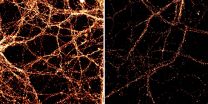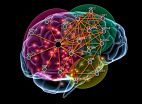(Press-News.org) If you're finding it difficult to stick to a weight-loss diet, scientists at the Howard Hughes Medical Institute's Janelia Research Campus say you can likely blame hunger-sensitive cells in your brain known as AGRP neurons. According to new experiments, these neurons are responsible for the unpleasant feelings of hunger that make snacking irresistible.
The negative emotions associated with hunger can make it hard to maintain a diet and lose weight, and these neurons help explain that struggle, says Scott Sternson, a group leader at Janelia. In an environment where food is readily available, their difficult-to-ignore signal may seem like an annoyance, but from an evolutionary point of view, they make sense. For earlier humans or animals in the wild, pursuing food or water can mean venturing into a risky environment, which might require some encouragement. "We suspect that what these neurons are doing is imposing a cost on not dealing with your physiological needs," he adds.
AGRP neurons do not directly drive an animal to eat, but rather teach an animal to respond to sensory cues that signal the presence of food. "We suspect that these neurons are a very old motivational system to force an animal to satisfy its physiological needs. Part of the motivation for seeking food is to shut these neurons off," says Sternson, whose team also demonstrated that a different set of neurons is specialized to generate unpleasant feelings of thirst. Sternson and his colleagues published their findings in the journal Nature on April 27, 2015.
Hunger affects nearly every cell in the body, and several types of neurons are dedicated to making sure an animal eats when energy stores are low. But Sternson says that until now, what scientists had learned about those neurons had not completely matched up to something we already know: hunger is unpleasant.
"There was an early prediction that there would be neurons that make you feel bad when you were hungry or thirsty. This made sense from an intuitive point of view, but all of the neurons that had been looked at seemed to have the opposite effect," he says. In earlier studies, researchers found that neurons that promoted eating did so by increasing positive feelings associated with food. In other words--not surprisingly--hunger makes food tastes better.
Some scientists had begun to suspect their ideas about a negative signal in the brain motivating hunger might be wrong. But their knowledge of the system was incomplete. AGRP neurons, located in a regulatory area of the brain known as the hypothalamus, were clearly involved in feeding behaviors: When the body lacks energy, AGRP neurons become active, and when AGRP neurons are active, animals eat. But no one had yet investigated those cells' strategy for generating that motivation.
Postdoctoral researcher Nicholas Betley and graduate student Zhen Fang Huang Cao began to address the question with a series of behavioral experiments. In the first, they offered well-fed mice two flavored gels - one strawberry and the other orange. Neither gel contained any nutrients, but the hungry mice sampled them both. Then the scientists' manipulated the hunger signals in the animals' brains by switching AGRP neurons on while they consumed one of the two flavors. In subsequent tests, the animals avoided the flavor associated with the false hunger signal.
In a reverse experiment, the scientists switched AGRP neurons off while hungry animals consumed a particular flavor. The animals developed a preference for the flavor choice that led to silencing of AGRP neurons, suggesting they were motivated to turn off the cells' unpleasant signal. In further experiments, the scientists found that mice also learn to seek out places in their environment where AGRP neurons had been silenced and avoid places where those cells were active.
Next, postdoctoral researcher Shengjin Xu used a tiny, mobile microscope to peer inside the brains of hungry mice and monitor the activity of AGRP neurons. As expected, the cells were active until the mice found food. What was surprising, Sternson says, is that mice did not actually have to eat to quiet the neurons. Instead, the cells ceased activity as soon as an animal saw food - or even a signal that predicted food. And their activity remained low while the animal was eating.
That wouldn't make sense if the job of AGRP neurons was to make food taste better or if they directly controlled the individual actions that go into eating, which were two possibilities, Sternson says. But to encourage eating, a negative signal would need to turn off when an animal consumed food. So their imaging experiments further supported what they had learned in their previous experiments.
The team later conducted similar experiments in which they manipulated thirst-sensitive neurons instead of AGRP neurons. Those neurons, found in a part of the brain known as the subfornical organ (SFO) behaved similarly: animals avoided places where the SFO neurons had been active, indicating that the cells generated a negative feeling. Again, the findings were consistent with everyday experience: "There's a similar motivational quality to hunger and thirst," Sternson says. "You want them to end." But although AGRP and SFO neurons motivate similar behaviors, their goals are very specific: AGRP neurons only drive animals to eat and SFO neurons only drive animals to drink. Recent independent work by HHMI researcher Charles Zuker at Columbia University has also shown that a circuit in the SFO regulates thirst.
In further experiments, Sternson's team will investigate similarities and differences between the two groups of cells. In addition, his group is interested in understanding more about how to interfere with the functions of AGRP neurons, which, in the future, might make it easier to keep those extra pounds off next time you go on a diet.
INFORMATION:
Johns Hopkins scientists have discovered that neurons are risk takers: They use minor "DNA surgeries" to toggle their activity levels all day, every day. Since these activity levels are important in learning, memory and brain disorders, the researchers think their finding will shed light on a range of important questions. A summary of the study will be published online in the journal Nature Neuroscience on April 27.
"We used to think that once a cell reaches full maturation, its DNA is totally stable, including the molecular tags attached to it to control its genes and ...
Eating 3,000 mg per day of salt or more appears to have no adverse effect on blood pressure in adolescent girls, while those girls who consumed 2,400 mg per day or more of potassium had lower blood pressure at the end of adolescence, according to an article published online by JAMA Pediatrics.
The scientific community has historically believed most people in the United States consume too much salt in their diets. The current Dietary Guidelines for Americans recommends limiting sodium intake to less than 2,300 mg per day for healthy individuals between the ages of 2 and ...
Survivors of Hodgkin lymphoma appear to be at higher risk for cardiovascular diseases and both physicians and patients need to be aware of this increased risk, according to an article published online by JAMA Internal Medicine.
Hodgkin lymphoma (HL) is a curable cancer with 10-year survival rates exceeding 80 percent. Treatment for HL has been associated with increased risks for other cancers and cardiovascular diseases, and those later cardiovascular complications may be the consequence of radiotherapy and chemotherapy in HL treatment, according to the study background.
Flora ...
Researchers have developed a large-scale sequencing technique called Genome and Transcriptome Sequencing (G&T-seq) that reveals, simultaneously, the unique genome sequence of a single cell and the activity of genes within that single cell.
The study, published today in Nature Methods, has experimentally established for the first time that when a cell loses or gains a copy of a chromosome during cell division, the genes in that particular region of DNA show decreased or increased expression. While this has long been assumed by genetic researchers, it has not been seen ...
CHESTNUT HILL, MA (April 27, 2015) - Add water to a half-filled cup and the water level rises. This everyday experience reflects a positive material property of the water-cup system. But what if adding more water lowers the water level by deforming the cup? This would mean a negative compressibility.
Now, a quantum version of this phenomenon, called negative electronic compressibility (NEC), has been discovered, a team of researchers led by physicists at Boston College reports today in the online edition of the journal Nature Materials.
Physicists have long theorized ...
Reluctance to share data about personal energy use is likely to be a major obstacle when implementing 'smart' technologies designed to monitor use and support energy efficient behaviours, according to new research led by academics at The University of Nottingham.
The study, published online by the journal Nature Climate Change, found that while more than half of people quizzed would be willing to reduce their personal energy consumption, some were wary about sharing their information with third parties.
Increasing energy efficiency and encouraging flexible energy use ...
April 27, 2015 -- A new breast cancer gene has been identified in a study led by Women's College Hospital (WCH) researcher Dr. Mohammad Akbari, who is also an assistant professor with the Dalla Lana School of Public Health at the University of Toronto. The study, which was published online today in Nature Genetics, describes how mutations in a gene called RECQL are strongly linked to the onset of breast cancer in two populations of Polish and French-Canadian women.
"Our work is an exciting step in identifying all of the relevant genes that are associated with inherited ...
New York, New York -- A multi-year study led by researchers from the Simons Center for Data Analysis (SCDA) and major universities and medical schools has broken substantial new ground, establishing how genes work together within 144 different human tissues and cell types in carrying out those tissues' functions.
The paper, to be published online by Nature Genetics on April 27 (at http://dx.doi.org/10.1038/ng.3259), also demonstrates how computer science and statistical methods may combine to aggregate and analyze very large -- and stunningly diverse -- genomic 'big-data' ...
Researchers at NYU Langone Medical Center have discovered that mitochondria, the major energy source for most cells, also play an important role in stem cell development -- a purpose notably distinct from the tiny organelle's traditional job as the cell's main source of the adenosine triphosphate (ATP) energy needed for routine cell metabolism.
Specifically, the NYU Langone team found that blocking the action of the mitochondrial ATP synthase enzyme stalled egg cell development from stem cells in experiments in fruit flies, one of the main organisms used to study cell ...
An international team of scientists has discovered what amounts to a molecular reset button for our internal body clock. Their findings reveal a potential target to treat a range of disorders, from sleep disturbances to other behavioral, cognitive, and metabolic abnormalities, commonly associated with jet lag, shift work and exposure to light at night, as well as with neuropsychiatric conditions such as depression and autism.
In a study published online April 27 in Nature Neuroscience, the authors, led by researchers at McGill and Concordia universities in Montreal, report ...

